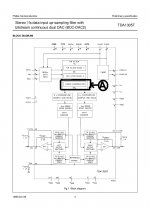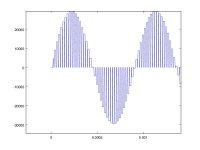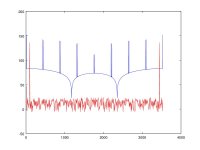By consulting a table of digital filter coefficients for a specified (frequency-domain) brick-wall reconstruction filter? Absolutely, definitely not by looking for a 'smooth' curve.
Oversampling aims to reproduce what would have been the sampled data between the existing points. The only way to do this is to implement a reconstruction filter, as only this can guarantee that it really has reproduced the original signal. Now of course, this filter can be simplified in the light of what we know the following analogue part of the filter will do - so the analogue and digital parts work together to provided a reconstruction filter. If doing this then it may be that the interpolation must not reproduce what the samples would have been, but instead produce what is needed to arrive at the correct final result.
Simply applying 'eye' solutions to 'ear' problems will not work, but for low frequencies can give sufficiently pleasing time-domain waveforms that newbies might be fooled into thinking that it works. This is because low frequency baseband signals give rise to quite low amplitude images, so sloppy filtering is good enough.
Oversampling aims to reproduce what would have been the sampled data between the existing points. The only way to do this is to implement a reconstruction filter, as only this can guarantee that it really has reproduced the original signal. Now of course, this filter can be simplified in the light of what we know the following analogue part of the filter will do - so the analogue and digital parts work together to provided a reconstruction filter. If doing this then it may be that the interpolation must not reproduce what the samples would have been, but instead produce what is needed to arrive at the correct final result.
Simply applying 'eye' solutions to 'ear' problems will not work, but for low frequencies can give sufficiently pleasing time-domain waveforms that newbies might be fooled into thinking that it works. This is because low frequency baseband signals give rise to quite low amplitude images, so sloppy filtering is good enough.
filter
What is a digital filter and how do you caculate extra samples fact no words
By consulting a table of digital filter coefficients for a specified (frequency-domain) brick-wall reconstruction filter? Absolutely, definitely not by looking for a 'smooth' curve.
Oversampling aims to reproduce what would have been the sampled data between the existing points. The only way to do this is to implement a reconstruction filter, as only this can guarantee that it really has reproduced the original signal. Now of course, this filter can be simplified in the light of what we know the following analogue part of the filter will do - so the analogue and digital parts work together to provided a reconstruction filter. If doing this then it may be that the interpolation must not reproduce what the samples would have been, but instead produce what is needed to arrive at the correct final result.
Simply applying 'eye' solutions to 'ear' problems will not work, but for low frequencies can give sufficiently pleasing time-domain waveforms that newbies might be fooled into thinking that it works. This is because low frequency baseband signals give rise to quite low amplitude images, so sloppy filtering is good enough.
What is a digital filter and how do you caculate extra samples fact no words
Is this a rhetorical question?gumo73 said:What is a digital filter
By taking the existing samples, zero padding them, and passing them through the appropriate digital filter.how do you caculate extra samples
Sorry, I used words. Words are useful when facts are required.fact no words
Digital interpolation
Do you konw what is a digital interpolation
What doing Block A in the image below ?
Is this a rhetorical question?
By taking the existing samples, zero padding them, and passing them through the appropriate digital filter.
Sorry, I used words. Words are useful when facts are required.
Do you konw what is a digital interpolation
What doing Block A in the image below ?
Attachments
Original pdf
Look the datasheet
Is this a rhetorical question?
By taking the existing samples, zero padding them, and passing them through the appropriate digital filter.
Sorry, I used words. Words are useful when facts are required.
Look the datasheet
Attachments
try these pictures of the absolutely bandlimited interpolation accomplished in practice by upsampling and low pass filtering
Over The Top?
although the point of the page is some interesting consequences of this type of interpolation
we're sorry we can't quickly point you to a webpage with what we all learned in courses, from textbooks tuned to just the exact questions/misunderstanding you have
we could spend hours with math software making examples just for you - but your attitude doesn't, make that easy
Over The Top?
although the point of the page is some interesting consequences of this type of interpolation
we're sorry we can't quickly point you to a webpage with what we all learned in courses, from textbooks tuned to just the exact questions/misunderstanding you have
we could spend hours with math software making examples just for you - but your attitude doesn't, make that easy
Intresting
Which do you think of him the best spline oversampling algorithm ?
For the x4 a different type from the that for x8 ?
try these pictures of the absolutely bandlimited interpolation accomplished in practice by upsampling and low pass filtering
Over The Top?
although the point of the page is some interesting consequences of this type of interpolation
we're sorry we can't quickly point you to a webpage with what we all learned in courses, from textbooks tuned to just the exact questions/misunderstanding you have
we could spend hours with math software making examples just for you - but your attitude doesn't, make that easy
Which do you think of him the best spline oversampling algorithm ?
For the x4 a different type from the that for x8 ?
Last edited:
It says linear interpolation, so I assume that is what it does. I assume the damage this will do is corrected by another digital filter.gumo73 said:What doing Block A in the image below ?
Oversampling
Do you know you can have a FIR without oversampling...
The oversampling is a digital interpolation that also has the function of filter...
It says linear interpolation, so I assume that is what it does. I assume the damage this will do is corrected by another digital filter.
Do you know you can have a FIR without oversampling...
The oversampling is a digital interpolation that also has the function of filter...
Yes. FIR is a class of digital filter. Oversampling is an application of digital filters.gumo73 said:Do you know you can have a FIR without oversampling...
No. The digital filter implements the interpolation. In the analogue world a filter is something which affects the frequency response (amplitude and/or phase) of a signal. In the digital world a filter is something which accepts a sequence of samples and outputs a different sequence of samples, with the output usually being some linear combination of the inputs plus (perhaps) previous outputs. A digital filter need not necessarily correspond to what we think of as a filter.The oversampling is a digital interpolation that also has the function of filter...
Is this a game of 20 questions?
No. The digital filter implements the interpolation. In the analogue world a filter is something which affects the frequency response (amplitude and/or phase) of a signal. In the digital world a filter is something which accepts a sequence of samples and outputs a different sequence of samples, with the output usually being some linear combination of the inputs plus (perhaps) previous outputs. A digital filter need not necessarily correspond to what we think of as a filter.
Therefore the oversampling is an spline algorithm
If by "spline" you simple mean 'piecewise' then yes, but this does not say very much. Most people talk of splines when they mean 'smooth to the eye'. You yourself mentioned this implicitly when you attempted to conflate video smoothing with audio reconstruction.
Perhaps we coud get back to talking about DAC settling time issues?
Perhaps we coud get back to talking about DAC settling time issues?
Settling time
On calculate maximum Delta Lsb if there is an oversampling it maximum value
depends on spline Algoritm
This Starting from original Delta_Lsb inside cd's tracks
If by "spline" you simple mean 'piecewise' then yes, but this does not say very much. Most people talk of splines when they mean 'smooth to the eye'. You yourself mentioned this implicitly when you attempted to conflate video smoothing with audio reconstruction.
Perhaps we coud get back to talking about DAC settling time issues?
On calculate maximum Delta Lsb if there is an oversampling it maximum value
depends on spline Algoritm
This Starting from original Delta_Lsb inside cd's tracks
Mouting output
I have tested a muting stage for output of the dac during
settling time .
Muting to 0V is a bad idea fft is worst than normal dac
Good question about the settling time definition. I believe this value gives the time needed to reach the analog output value that is within +/-1LSB of the ideal value. So if you mute the output for 0.2 us after the conversion time, you could eliminate this error.
I think muting of the unwanted part is better than sample-and-hold of the wanted part.
I have tested a muting stage for output of the dac during
settling time .
Muting to 0V is a bad idea fft is worst than normal dac
This is interesting, have you shot some photos?I have tested a muting stage for output of the dac during
settling time .
Muting to 0V is a bad idea fft is worst than normal dac
Simulations
This is results of simulation with octave/matlab
Red is original place to the 1100hz (fft)
Blue is the output after muting (fft)
This is interesting, have you shot some photos?
This is results of simulation with octave/matlab
Red is original place to the 1100hz (fft)
Blue is the output after muting (fft)
Attachments
- Status
- Not open for further replies.
- Home
- Source & Line
- Digital Source
- DAC Settling Time


